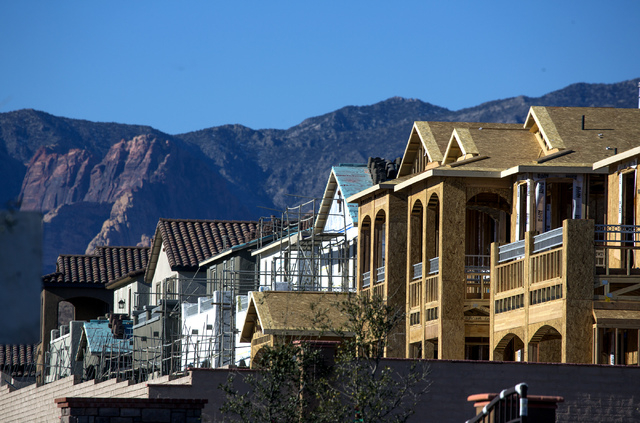New limit on FHA loans poses potential block to housing recovery

A housing market on the brink of recovery has a potential new hurdle in its way.
Local real estate observers say they’re concerned about a Jan. 1 rule that dramatically lowered the size of mortgage the federal government will back in the Las Vegas market. The lower loan limit could hurt buyers with small down payments and derail a nascent revival in the homebuilding sector.
“The timing is not good. We’re trying to get the market re-established, especially in Las Vegas, and to drop the limit now doesn’t make any sense,” said Dennis Smith, president and CEO of local analysis firm Home Builders Research. “We need to get as many housing sales and starts as we can to boost the economy.”
Here’s how the rule works: The Federal Housing Authority sets the maximum loan size it will guarantee based on a market’s typical asking price. The high is usually 115 percent of the median, though during the boom in 2005 and 2006, it went up to 125 percent of the median. In Las Vegas, thanks to a bubble-era median home value of nearly $300,000, that meant the authority would back loans worth as much as $417,000.
The government’s maximum historically varied year to year as median prices fluctuated, but the housing authority froze the ceiling in 2008 — until now. Not only did the authority adjust its limit based on 2013 prices, it also dropped its multiple from 125 percent back to 115 percent. With an overall median resale price hovering around $155,000 and a single-family median of about $185,000, that translates into a new federal loan limit of $287,500 — a drop of more than 31 percent.
“The formula is not anything new. But they put a freeze on it for five years, so we all forgot about it. In a normal world, I can’t complain about the way they calculate it,” said Nat Hodgson, executive director of the Southern Nevada Home Builders Association. “Going from $417,000 to $287,500 is a bit much given how hard-hit some markets were. We’re still devastated here. We’re finally just getting off the ground.”
Throw in new federal rules on qualified mortgages, which cap fees lenders can charge borrowers and require banks to document a homeowner’s ability to pay back a loan, and you have a big potential drag on the market, Smith said.
The lower mortgage limit doesn’t necessarily mean major hard times for housing in Southern Nevada, though, said Heidi Kasama, president of the Greater Las Vegas Association of Realtors.
That’s because federally guaranteed loans are not a huge part of the local market. Kasama, a broker with Prudential Americana Group, Realtors, said her firm’s research shows that federally backed loans made up 15 percent to 20 percent of the Las Vegas Valley’s market in 2013. Of that, roughly 10 percent to 20 percent were on homes priced above the $287,500 threshold. That’s basically two to four properties out of every 100 sold.
The new rule “might have a very slight impact on the market, but it won’t be an overwhelming number,” Kasama said.
What’s more, the qualification standards don’t differ much between federally guaranteed mortgages and conventional loans, Kasama said. The government requires a 3.5 percent down payment, while conventional lenders want to see at least 5 percent. Credit scores need to be around 580 for a federally backed loan, and 620 for a conventional one. So at least some borrowers who can’t get government backing should be able to squeak by under conventional criteria.
“I think most people would be able to come up with the down payment” for a conventional mortgage, she said.
But the lower price limit isn’t the only issue, Hodgson said. Federal and conventional loans differ significantly on the amount of time they allow between a short sale, foreclosure or bankruptcy and a buyer’s next home purchase. The Federal Housing Authority lets buyers back in after as few as one to two years, provided they have no other credit dings. Conventional lenders, on the other hand, look for as many as three to seven years after a short sale or foreclosure, and 10 years post-bankruptcy.
“There are a lot of people here who have good credit except for a house investment they made at the wrong time,” Hodgson said. If federal backing isn’t an option for them, they may not have anywhere else to turn.
The problem is even more acute for Hodgson’s constituency — homebuilders. There is already a huge gap between the resale median and the new-home median, which was $289,521 in October, according to local research firm SalesTraq. The new federal limit is just one more competitive obstacle for builders to maneuver, he said.
So the builders’ association is appealing the new rule to the federal government, which moved its appeals deadline from Jan. 6 to Jan. 31. Hodgson said he and his members are working with federal lawmakers to freeze the ceiling at $417,000, at least for a bit longer.
“Someone just needs to wake up and do the right thing, and the right thing is to not do anything right now,” Hodgson said. “We’re not asking for a raise. We’re just asking if we can freeze it until we get back to normal.”
Though she doesn’t think the smaller limit will hurt big numbers of buyers, Kasama said she agrees the maximum loan amount should be higher for the near term.
“It just doesn’t make sense at this time, as tenuous as our housing recovery is. We had a 24 percent price increase last year, and inventory is slowly coming up,” she said. “We’re on a healthy trend, but we’re just getting out of years of extreme difficulty. We don’t want to see anything happening this year that has any impact. We want to make sure we keep up the momentum we’ve started.”